by Winding Pathways | Nov 5, 2020 | Travel/Columns
Amazing Autumn Across America
You can still catch the color this fall as these amazing days stretch on. Even in the derecho band of destruction from Eastern Nebraska through Illinois, some trees offer eye candy in November to lift our spirits. Outside the narrow tunnel of downed trees, the world is quite stunning.
A recent Iowa outing found us motoring north on IA 150 and US 52 past fields of ripening corn and bean of various hues – green-yellow and earth-brown to russet – undulating over the rolling landscape. The descent into the Volga, Turkey, and Upper Iowa River valleys offered pleasing, pastoral scenes of church spires, roadside stands replete with pumpkins and apples, trails busy with bicyclists, and rivers dotted with bright kayaks.
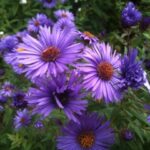
Asters of all varieties brighten the ditches.
The roadsides and hillsides are most interesting where patches of prairie have been planted, and milk cows and horses graze. New England, many-flowered, and heath asters contrast purple, pink, and white against the tawny hues of big and little bluestem waving in the wind.
Country tree color is more subdued. Walnut, hackberry, locust, and catalpa tend to turn dull yellow and drop their leaves early. Shrubs like flowering, red twig and grey dogwoods, and ninebark do form pleasing borders of various reds and tans. You can always spot the brilliant sugar maples often the only remnants of a long-gone farmstead. All contrast with the varied greens of pines, spruces, cedars and even, verdant cover crops.
Colorful Communities
Color is most vibrant in towns, parks, cemeteries, and on golf courses. Overflowing flower baskets and bright banners line the main streets of towns like Independence and Calmar. Ashes and maples brighten residential streets. The streets radiate yellow of green ashes and deep plum of white ashes. These contrast with the maple coloration which ranges from fiery orange/yellow to brick red to wine.
Around toward the Mississippi River, the vistas could not be more pleasing. In autumn, a light mist rises over The River. The sun slants through brightly colored leaves spotlighting golden Cottonwoods dancing in the breeze.
Peaceful Parklands
To get a sense of the close-up beauty of fall, pull into any of the several state or county parks, preserves, or recreation areas and step onto the trails. One of our favorites is Effigy Mounds National Monument. The short climb up the bluff offers a spectacular view of the Mississippi. Along the way, we noted yellow-green grape leaves framed by merlot-infused Virginia Waterleaf.

Monarch
Around Cedar Rapids, as trails open up, look closely at the goldenrod and Maximillian sunflower where pollinators still busily work. Late migrating Monarchs rest and snack waiting for the next north wind to head south.
Go South for Color
It seems that as the winds knock early changing leaves like maples off, the oaks come into their own and linger into the fall. All the oaks, especially our state tree, the bur oak, sport handsome ginger, tawny, sepia and, rufous shades. Pin oaks with their downward slanting lower branches often hold their leaves through winter.
A short drive south offers even more opportunities to catch the oak colors. A great source to decide your route is the scenic byways of Iowa. Not surprisingly, most routes follow The Mississippi or other Eastern Iowa rivers. The pdf includes pictures, text and routes to follow.
-
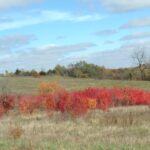
-
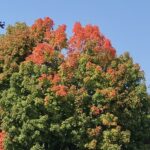
-
A scarlet maple.
-
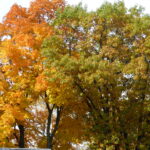
-
White, Pin, Red Oaks all turn different colors in the fall.
-
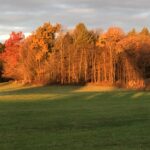
-
Travel early or late in the day to catch the most vibrant colors.
Enjoy the eye candy of Iowa’s fall colors.
Editor’s Note
No matter where you live in the Northern Hemisphere, early November holds color in surprising places. Go early in the morning or later in the afternoons to catch the sun’s lowest angles highlighting trees and landscapes. America’s Byways is a state-by-state resource of interesting trails to follow. And, any country road is sure to bring delightful surprises.
by Winding Pathways | Jan 23, 2020 | Gazette Features, Geology/Weather, Nature, Travel/Columns
Winding Pathways invites readers to enjoy past features in the Cedar Rapids Gazette.
Wandering Nebraska and South Dakota’s Rich Fossil Freeway. Follow US Highway 20 across northern Nebraska while exploring its fossil-rich history. Along the way wet your line in trout streams, paddle clear rivers through sandhills, camp in a National Forest in the Great Plains, and bicycle parts of the Great American Rail-Trail. Then, end up in the enchanting Black Hills of South Dakota.
Alaska In Winter. Most folks experience Alaska in summer. Winter has its rewards, too! Plenty of activities for outdoor enthusiasts and mild-mannered indoor types. Museums. The Bear Tooth Theatrepub. Great eateries. Iditarod Ceremonial Start. XC ski races. Campbell Creek Science Center. And, perhaps most wonderful of all – no skeeters or bears!
Indiana Dunes National Park. A great stop while speeding along I-80 is the Indiana Dunes National Park. A cooperative venture among city, county, state and federal government, this necklace of preserved areas rings the southern end of Lake Michigan. Soft sand beaches to explore, dunes several hundred feet high to scale, charming villages, bicycle trails to follow, and varied places to rest your head at night. This new national park can fulfill any family’s vacation dreams.
America’s Magnificent Mounds line the Mississippi River and many other waterways in North America. While most mounds have been lost to “development” many remain. And, travelers can learn so much about ancient cultures and appreciate why preserving these mounds is important.
by Winding Pathways | Jan 2, 2020 | Birds, Nature, Travel/Columns
As dusk enveloped us, Sandhill Cranes winged over in groups of three or four, heading for their overnight roosting sites. We were at the Aldo Leopold Foundation near Baraboo, Wisconsin.
Conservation philosophers often cite three authors who framed the modern environmental movement. Perhaps Thoreau’s WALDEN is most famous. Somewhat later, John Muir penned the value of wilderness and national parks. More recently Aldo Leopold’s 1949 book, A SAND COUNTY ALMANAC, articulated society’s need to embrace a land ethic.
Extinction of Species
During Leopold’s life waterfowl, Passenger Pigeons, Sandhill Cranes, and many other birds declined in number under widespread habitat destruction and market hunting. The pigeon became extinct, and Leopold believed Sandhill Cranes would soon follow.
Happily, thanks to protection, education, and habitat improvement thousands of cranes now gather each fall near the Leopold Center on their way south. We had the good fortune to spot and hear many.
Foundation of Personal and Professional Life
In the winter of 1971 Rich worked as an elementary school custodian. “If I hustled and got the restrooms cleaned and the halls swept, I could take a short break in the janitor’s closet. There, surrounded by mops and brooms I read WALDEN and SAND COUNTY. They framed my personal and professional life,” he said.
Leopold was one of the first scientists to encourage making degraded land healthier through ecological restoration. His words inspired us to devote 40 years restoring prairies in Kansas and Iowa. Our Winding Pathways yard of waving wildflowers and tall grasses are a living tribute to Aldo and Estella Leopold.
A Walk into the Past Connects Us to the Present
Recently, Leopold Foundation Fellow Eudora Miao led us down a narrow path between tall pines to a former chicken house. In the 1930s the Leopold Family converted it to their weekend getaway cabin and called it simply, “The Shack.” Starting in 1935 they planted thousands of pines and acres of prairie on their eroded and barren land. It was here that Aldo penned words that have inspired people for the past 70 years.
The Foundation strives to inspire an ethical relationship between people and nature through Leopold’s legacy.
We were thrilled to visit the Foundation, tour their amazingly energy-efficient headquarters, visit The Shack, and interact with staff. Put SAND COUNTY ALMANAC on your reading list and visit the Foundation. It’s about ten miles from downtown Baraboo, Wisconsin, and about an hour’s drive north of Madison.
For information visit The Aldo Leopold Foundation
Photos (mn) by Mark Norlander.
-
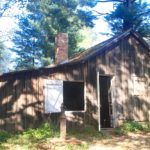
-
The converted chicken coop is on the Historic Register. mn
-
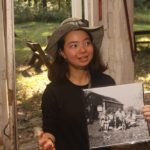
-
A skilled Fellow of the Leopold Center shares about The Shack. mn
-

-
Sand hill Crane populations have increased.
-
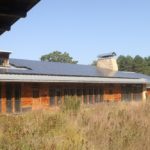
-
The main building of the Leopold Center has Platinum LEED designation. mn
by Winding Pathways | Dec 19, 2019 | Gazette Features, Travel/Columns
Iowans share history with Baraboo, Wisconsin. Two famous families began their lives and careers in Iowa and landed in Baraboo. This fall we toured the charming town of Baraboo, took in Circus World, and basked in the glow of the Leopold Center’s work on sustainability. Read about Baraboo and plan your own adventure in the Cedar Rapids Gazette.
by Winding Pathways | Nov 7, 2019 | Nature, Travel/Columns, Trees
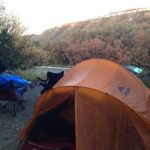
Enjoying Iowa’s forests.
Iowa is one of the states with the fewest trees, yet in the late 1800s we were the Lumber Kings of the World! And,

Notice the tree rings on this wide board from New Hampshire
Clinton, Iowa’s minor league baseball team proudly retains that name – Lumber Kings! Why? Read The Green Gazette (9-29-2019, Living L-09 and 10) to learn about Iowa’s forest industry, where you can camp today in quiet forests and how lumbering put Clinton, Iowa, on the map.












